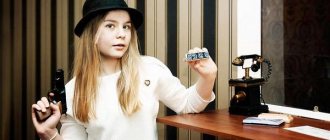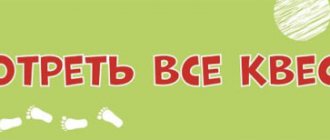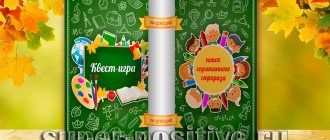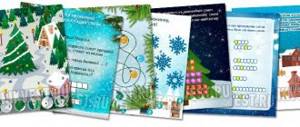Every day the popularity of quests is growing - more and more people are learning about them. And many people have a desire to come up with their own quest for some holiday for their family and friends. Coming up with tasks for a quest is not an easy task; here you will have to call on all your imagination, ingenuity and resourcefulness to help.
It is worth noting that puzzle-solving games are loved not only by children, but also by adults. Over many centuries, humanity has come up with a huge number of riddles, charades, logic problems and other tasks that can not only diversify leisure time, but also help develop mental skills and thinking.
In this article we want to tell you how you can apply many well-known and favorite tasks from childhood to your quest. Pay attention to the main condition - the answer to the task must be a word denoting a place or object, and which can serve as a kind of hiding place. After all, a quest is a chain of tasks, each of which is hidden in a certain place. Having completed the next task, players learn the key word, and it tells them where to move next. At first glance, it may seem that the answer in the form of some word is obtained only when solving puzzles, crosswords and riddles. In fact, you can even get a word in a puzzle like origami. And we will tell you how to do this in this article.
How to choose keywords for a quest
The core of the quest is the puzzle cards and the locations that the answers to those puzzles point to. After all, as we wrote above, all tasks are hidden in various places and objects.
Places and words denoting them can be common, found everywhere: bed, TV, door, window, etc. Or they can be specific, found only in a specific room or in a specific area. For example, you can use the names of indoor plants, books, tourist souvenirs, etc.
Or it happens that one word has a double meaning for some people. An example could be this: there is a cat in the family, the household jokingly calls him Loaf, or, well, Sofa) So this word can be made the key word in the quest. Having received the word “sofa” in the answer, players will not immediately realize that they need to run not to a real sofa, but to the cat or to the place where he sleeps or eats. Such funny moments will make the game more fun and interesting. They will add individuality to the quest and tasks, show that the organizer put his soul into the process and took into account the interests and passions of loved ones.
A similar example can be given with the use of souvenirs from trips around the world. For example, you have a plate hanging on your wall - a souvenir from Paris. This is an excellent reason to add a task to the quest, the answer to which will be something related to Paris or France. Maybe even the word “Paris” itself.
There are many similar examples. But we will not delve into them, since the purpose of this article is to give advice on how to come up with tasks for a quest yourself, for example, for a birthday. We will also use specific examples to analyze how to adapt and implement various types of puzzles into the quest. We will, of course, share some secrets, but we won’t reveal them all just yet. The examples of tasks presented below are taken from our quests, which you can view in the catalog.
Now let's look at how different types of tasks can be “modified” so that the answer to them is a word - the name of an object or place. Only then can you include this task in the quest.
Personnel
Let's start with you. Since in order to open your own quest, you can do without additional hiring of agents - 2-3 organizers are enough - you will need a keen interest. Experience in event companies and at least basic skills as an event host are also desirable. Scripts, as we have already said, can be ordered on freelance sites or, for example, organized a competition on social networks.
In general, the more complex and interesting your quests are, the more non-player characters you will have to involve in them. At first, you can attract friends and hire third-party people, for example, with payment for time. In the future, it is better to form a staff of your own agents, each of whom can take part in several quests at once.
Types of tasks for the quest
Conventionally, we divide the huge variety of types of puzzles and tasks into categories. Below we will look at some of them.
"Verbal-letter tasks"
Their essence is to correctly enter the answers (words and letters) into the required cells. As a result, a keyword will appear in the highlighted cells, which will lead players to the next task. A classic example of such a task is the most common crossword puzzle, after completing which you need to read the keyword in the highlighted cells.
Similar tasks include:
- Crosswords
- graphic crosswords
- teawords
- tasks “song” or “poem”, where you need to enter the missing words in the text and form a keyword from the letters in the highlighted cells.
"Simple tasks"
The key word is either a riddle, a charade, or a question of erudition or specific knowledge. Here is an example of a famous charade:
The beginning is the voice of a bird, The end is at the bottom of the pond. And you can easily find the whole thing in the museum.
Answer: CAR + TINA = PICTURE Example of a question with the answer “MIRROR”:
"Rebuses"
You need to compose and solve puzzles according to generally accepted rules that can be found on the Internet.
Most often, a rebus is a combination of pictures, letters and numbers. The task is to write down the names of these images in the correct order and then decipher the keyword or phrase.
"Logic Puzzles"
It is difficult within the scope of this article to describe all the many ways to use logic puzzles for home quests. Maybe in the future we will devote a separate article to this. In the meantime, here is one good example of how a well-known type of puzzle with matches can be adapted for use in an escape room:
"Filwords"
There can be many use cases here. In a fillword, you can guess a word by scattering its letters among the false letters. In this case, all false letters will be repeated, and the letters of the keyword will appear only once. In this case, the task should be formulated as follows: cross out all the repeated letters, and form a word from the remaining ones.
Or a fillword can be the intersection of many words that, according to the assignment, will need to be found and crossed out. And the remaining letters should form a keyword.
Another option for using a fillword is to hide three or four words among the false letters, which together would give a hint of the keyword you need. For example, the words hidden on the letter field are: soup, lid, kitchen. The word connecting them will be pan. This is where you need to hide the next puzzle or the final prize.
“Find differences or an extra object”
Such tasks are great for any children's quest, especially when children cannot read yet, and using word tasks is not suitable for you. If the task says to find an extra object, then you can, for example, in the image of a New Year tree, “hide” a saucepan, a washing machine, or any other ridiculous thing among the toys. Organize another cache there. If in the task you need to find differences, then the players are given two pictures, on one of which they need to provide the “key” difference.
"Find an object without a pair"
Like the previous tasks, great for children. The card depicts various objects with their logical pairs in a chaotic order. For example: brush - paint, TV - antenna, match - fire, etc. We are conceiving one item without a pair, it will be the key one.
"Labyrinths"
Can be used in two ways. In the first case, the labyrinth will be a regular puzzle with several exits. An item must be placed at each exit. The item planned in the quest outline is placed at the only correct exit.
The second application option is more interesting for adults and children who can read. Letters are scattered along the paths of the labyrinth in such a way that only after following the correct path can you read the key word.
"Logical chains"
For children, you can use logical chains listing repeating items.
For adults and children who are good with mathematics, you can come up with various chains with numerical patterns. The numbers missing in them must correspond to the serial number of the letters in the alphabet. The letters are guessed exactly from the keyword you need.
“Tasks with collecting letters”
The point of the tasks is to collect the necessary letters to compose a keyword. You can come up with a lot of options here.
For example, the letters of a word can be randomly placed on any picture, preferably with a thematic focus. Immediately imagine a number of small fragments of the same picture. Each fragment must correspond to the location of one of the letters of the keyword.
A collection of letters can also be conceived in a table at the intersection, for example, the names of countries and cities that are located in them. This puzzle can be made on any topic: literature, geography, sports, art. It is she who will help take into account the hobbies and interests of the players in the game.
"Ciphers"
Nowadays almost no quest can do without this classic technique. The keyword is encrypted with shapes, pictograms, flowers, snowflakes, in general, any icons corresponding to the theme of the game. Using the alphabet, where each character corresponds to a letter, players must read a message, a riddle, or just a keyword.
"Puzzles"
We discussed the issue of using riddles in quests in detail in the article Riddles for quests. In it we talked about how to correctly use riddles in an quest, how ordinary riddles can be turned into interesting puzzles, showed several interesting ideas, and also published lists of riddles about various household items. You can also find a list of riddles about various household items here:
- Riddles about the Fridge for the quest
- Riddles about the Mirror for the quest
- Riddles about the Wardrobe for an quest
- Riddles about the Sofa for the quest
- Riddles about the Washing Machine for the quest
- Riddles about TV for quest
"Special tasks with secret inscriptions"
These are the most entertaining quests. These include tasks using sympathetic ink or the use of any manipulations to manifest a message on paper. Ink that becomes invisible after drying, but appears when heated, can serve as: milk, lemon juice, starch solution.
You can reveal the secret inscription in other ways. For example, you need to take two sheets of paper, place them one on top of the other and write a message on the top sheet, pressing firmly on the pencil. On the bottom sheet, at first glance, the inscription is not visible, but if you take a pencil and paint over it, the pressed inscription will appear.
The principle of operation is similar for this task: write a word, a message on a piece of paper, or draw a picture with a colorless wax candle. If you then paint over the sheet with a pencil, the secret image will appear, as it will remain white.
An interesting task for a children's quest is a message that can only be read with the help of a mirror. On the sheet you need to write a riddle or phrase in a mirror image. Having received such a task, players must guess how to use a mirror and read the text.
Developing tasks for a spy quest will not be complete without making a stencil, which can also be used to receive a secret message. To do this, you need to take a newspaper clipping, select the necessary letters in the text for the intended message, and make slits in the right places on a blank sheet of paper. This quest works especially interestingly when players find a stencil and a newspaper clipping at different stages of the quest.
The third stage - advertising and attracting customers
For many, at this stage, franchise assistance ends with the provision of a reservation system on the website. We went further by creating a marketing agency for quests: our staff includes specialists in Yandex.Direct, Google Adwords, VKontakte targeting, a copywriter, an email specialist, and content specialists.
We understand that traffic is one of the most important stages, therefore a designer and a programmer work on website conversions, we have written our own analytics system.
Since most clients call rather than sign up on the website (up to 90% in the regions), we are the only ones who have introduced a single call center for all our partners, which provides daily online service from morning to night, without holidays and weekends.
To improve the quality of processing applications, we were forced to write a separate CRM system for processing applications with elements of hints, since it is very difficult to remember 150 quests in 40 cities, but with such a system, information on each reservation, for each client, for each quest is presented conveniently for increasing the number of records.
The introduction of a call center shows an increase in bookings by 30% due to the quality of application processing, scripts and the application processing system.
Types of advertising
We divide advertising into two categories: online advertising and offline advertising in the city. We provide detailed information about offline advertising in the training. But we take care of setting up and maintaining online advertising. This is contextual advertising in search engines: Yandex and Google. Social networks: VKontakte (targeting), Instagram (again, we won’t list the rest, but there are significantly more sources of Internet traffic than just search networks).
Based on this advertising, we determine the budget together with you. We monitor advertising on a weekly basis and adjust it according to your wishes.
Individual tasks
Above we described only a small part of the tasks that can be used in the quest. In our scenarios you will find many other original and unique tasks.
We try, whenever possible, to include so-called individual tasks in our quests. They help to personalize the quest and give it the appearance of an individual, designed specifically for a specific person or company.
For example, the task “Our Date” in the Romantic quest (link to the rum quest) is based on the date the couple met. Without remembering it, it is impossible to solve the task. A similar type of task “Do you know me well” with personal questions is also irreplaceable if the quest is being prepared for a loved one.
Remember
- There is a big difference between an interesting idea and a profitable business. Before opening a questroom, evaluate the demand for the service in your region, the success and range of competitors, and the financial prospects of the project.
- The success of such an enterprise directly depends on the size of the initial investment.
- The quest market is interesting, but already saturated in most cities.
- There are many offers to sell a franchise, but the justification for purchasing it must be carefully weighed.
- If preliminary calculations do not give a comforting forecast, then it is better to visit game locations only as a participant.
Good luck to you and see you again!
( 4 ratings, average: 5.00 out of 5)
Our quests
Developing tasks for an quest is not only about coming up with original puzzles for the quest. Be sure to take the time to include some moving tasks into the quest. They will help diversify the quest and keep players from getting bored.
When purchasing most of our scenarios, we give our customers a specially designed set of active tasks for the quest.
The set includes tasks according to which players must perform certain active (physical or creative) actions. If completed correctly, they move on to the next stage and receive another puzzle or task.
Please note that quests usually do not imply the participation of the presenter in the game process, because players find tasks themselves, solve them themselves, and receive hints on where to look for the next ones. If you enter active tasks, the participation of the presenter will become mandatory.
Marketing
As a rule, potential clients look for quest makers on the Internet, so an optimized website with available quests, schedules and prices is simply a must have. In addition to promoting the site, also do not forget to connect social networks, context, banners on regional forums and city portals. Well, of course, word of mouth, the development of quests in your city and the reputation of your direct competitors will play a big role: if a person liked a quest from another company, then he will most likely turn to you next time.
What else might work? Flyers and business cards in crowded places of potential players. Active blog with reports on the latest events. Discounts for regular customers, free games on certain days, competitions for the best script. Don’t be afraid to experiment – the field itself encourages this!
Ceilings
What players see above their heads is a false ceiling made of black perforated steel sheet. This solution is very convenient because all communications can be hidden behind the ceiling. You can easily organize air conditioning and ventilation without worrying about the grilles sticking out in the most inappropriate places. Behind the ceiling are speakers and microphones. Finally, the ceiling hides some of the puzzle mechanics. To prevent anything from shining through the false ceiling, all surfaces above it are painted with matte black paint. Here is the installation of wiring behind the ceiling:
What is a business plan?
The main component of success for any business is a well-written business plan, and if you decide to organize a quest in your own city, then the procedure for drawing up a business plan should be carried out with special care. All calculations are carried out in order to determine the profitability of a business in a particular locality, as well as calculate the approximate payback time. That is, the entire business plan is a set of income and expenses, both one-time and monthly.
Touch buttons
So that the remote control does not seem like a lifeless piece of plastic, they decided to put more different buttons and lights on it, which do not do anything useful, but create an ambience.
Our ship is from the distant future, so we can’t spoil the minimalist design with toggle switches and switches. It was decided to make the buttons touch sensitive. Each sensor is a separate small board on which a microcontroller (ATtiny13) and an RGB LED are mounted. The remote control is made of a sheet of white plastic, and the sensors are attached to the underside of this sheet. The plastic is translucent, so the LED shines through without anything sticking out. The circuit reacts to touching the panel by changing the antenna capacitance. The antenna is a piece of wire fused into the panel from the inside. This is what sensor modules and antenna blanks look like:
Each module is glued into place, connected to the antenna and power. A hole is cut under each button, into which it fits when the panel is installed in place:
There are about 100 such modules in total. Due to mass production, they turned out to be even cheaper than ready-made backlit mechanical buttons (not to mention touch ones).
Quest for your husband's birthday - a cool scenario for congratulating your loved one right from the early morning!
Birthday. Morning. The birthday boy wakes up to the sound of an SMS: “A surprise awaits you in your mailbox.” The birthday boy hurries down to the mailbox, from which he takes out an elegant envelope with congratulations and an explanation of the further course of events.
The letter says: “My beloved birthday boy! I really want to sit down with you at the festive table and wish you everything! But when this happens depends only on you. After all, the gift prepared for you must be found by yourself. How? It's simple. Be attentive to the signs that will help you act in the right sequence. I think that you will successfully cope with everything yourself, but if you need my help, then for each hint you will have to wash the dishes instead of me. Of course, not on this glorious day of your birth: you will owe it in the future! Good luck to you. I'm rooting for you!"
The message is accompanied by mysterious rhymes:
“The golden ball is spinning and spinning, The golden ball is not empty at all. The ball has a hidden secret, In this secret you will find the answer.
PS Yes, greetings from Koshchei to you too!
Greetings from Koshchei are a decorative pin or needle stuck into the postcard, symbolizing the immortality of the fairy-tale character. I wonder what it's for?
1. While the puzzled husband is reading a mysterious message near the mailbox, the wife quickly hangs three pre-inflated balloons right outside the front door: red, yellow, blue. In yellow she puts the key to the next action. It is the yellow one, also known as gold, that needs to be pierced with the received needle, since it is in it that the note with the task is located. The song “Blue Ball” can confuse your husband and force him to choose a blue ball. Well, then you'll have to wash the dishes over time. But we believe that the birthday boy does not fall for minor provocations and takes out an instruction note from the punctured yellow balloon.
2. A note from a yellow balloon with the following content: “Here are mixed fragments of three phrases from three very popular songs of the Soviet period. Namely: “Smile, they still walk and run away in the world if they are in a quarrel.” This is taken from the lyrics of the following songs: “Five Minutes” (film “Carnival Night”), “Antique Clock” performed by A. Pugacheva and “Farewell to Love” (V. Kikabidze). The songs are dedicated to one important thing in the life of every person. Guess what this thing is? Find her. It is clear that the answer is “a clock,” and the quick-witted birthday boy moves towards a wall or floor clock or other outstanding clock located in the apartment. His goal is to receive instructions for his further actions. Attached to the back of the clock are 2-3 photos of the wife in front of the furniture, to which the next clue should be attached. This is where you need to pay special attention to the furniture.
3. The birthday boy, guided by the photo, must find this furniture in the house. A box of colored pencils is attached to this part of the furniture set. The box says: “Give yourself a rainbow”! The box contains seven pencils: purple, blue, cyan, green, yellow, orange, red. A printed letter is attached to each with tape. The correspondence is as follows: purple – “B”, blue – “D”, blue – “I”, green – “B”, yellow – “A”, orange – “H”, red – “E”. Collecting a rainbow involves arranging the pencils exactly in the sequence of rainbow colors. Or draw with them in the required sequence, paying attention to how the corresponding letters form a word. Then the birthday boy will easily read the next instruction “IN THE SOFA” and rush to the sofa.
4. And between the cushions of the sofa, the first incentive prize awaits him - a box of chocolates. But at the bottom of the box there is another riddle. This is a puzzle. On a cardboard sheet of postcard size, write, beautifully decorated with colored felt-tip pens, a line from V. Vysotsky’s song: “Light the stove for me in white.” Write and cut into several parts so that the birthday person can deal with the puzzle. Let him collect it.
5. Without a doubt, having completed the puzzle, the birthday boy will guess to look either in the oven or in the microwave. And there the following instructions await him: “If it doesn’t burn in fire, then where to go?”
6. And our birthday boy goes straight to the bathroom, where a bottle of whiskey awaits him - another gift from his wife with an elegant sticker containing an acrostic:
Toropyshka was hungry and dropped the cold iron. He shined the lantern for a long time, Only one Needle was found!
If the wife relies on her husband’s natural ingenuity, then the first letters of the lines need not be highlighted. The absurdity of the verse should suggest that the idea of further search is hidden not in the meaning of the message, but in the form of construction or something else.
7. So, “SHOES”. The husband should inspect several pairs of his shoes. In one of the pairs he finds a recommendation: “Set a course for the North Pole”! The birthday boy goes to the refrigerator and opens the freezer. The chamber contains a frozen ball or rubber glove with a note and the following prize: a keychain. The balloon is defrosted by the birthday boy under hot water. You get a keychain and a note with the following content: “All secrets are hidden in the ground.” In the ground and at home, where is it?
8. Of course, in a flower pot! You'll have to dig around a little to bring to light another elegantly decorated square of cardboard with a mysterious inscription:
Four elements in the world Today you met only three of them. Find the fourth one too. And your heart will beat in your chest!
9. The birthday boy has to think: what are the main four elements in the world? The answer is obvious: Earth, Water, Air and Fire. Which of them has not the birthday boy encountered yet today? Of course, with the element of Air. And his path lies on the balcony: where else does His Majesty Air reign? On the balcony, a bright, beautiful envelope is attached to the clothesline. It contains a flash card with just one audio file.
10. Having inserted it into the computer and having enjoyed the wonderful old song “The highest dream is height”, the husband is unlikely to have any doubts that the treasured main gift is hidden in the highest place in the house - on the mezzanine or maybe even on the chandelier . It's up to the hostess to decide. To make the decisive final assault easier for your beloved husband, stick an airplane on this treasured place. Let there be a hint.
We hope that thanks to this quest, the morning of the birthday will be fun and will give an excellent festive start to the whole celebration!
Sources
- https://prazdnik-dlya-vseh.ru/den-rozhdeniya/kvest-po-poisku-podarka-v-kvartire.html
- https://podarikvest.ru/den-rozhdeniya-dlya-vzroslyh
- https://101prazdnik.com/den-rozhdeniya/dr-stsenarii/kvest-na-den-rozhdeniya-muzha.html
- https://snova-prazdnik.ru/zadaniya-dlya-kvestov/
- https://super-positive.ru/podarok-kvest/
- https://golova-idea.ru/prazdniki/scenarij-kvesta/.html
Business relevance
Over the past few years, the development of the gaming industry has moved to a new level. It turns out that adults love to play various games no less than children, and they are willing to pay real money for it in order to experience unforgettable emotions. Therefore, the smartest individuals began to come up with not only quests for children, but also similar entertainment for adults. Now everyone can feel like a detective, a spy, a victim of a serial maniac, or become the last person alive on earth, solving intricate puzzles. All this became possible only thanks to quest rooms, which almost completely erase the line between human imagination and the real world.
As a business, quests for children and adults look no less interesting - excellent profitability, quick payback, good profits, incredible prospects for development and the opportunity to do a truly interesting job. However, the businessman also faces some pitfalls associated with the development of such a business - regular advertising costs, a high threshold for climbing, a direct dependence of profits on special effects and decorations, as well as the need to constantly develop a new script.
Have you decided to organize a quest? Remember that the target audience of such a business is young people aged 22 to 35, but 14-year-olds can also come and have fun. Most of these clients are active users of the Internet and social networks, so it is necessary to focus on advertising on these platforms. For example, you can order PR from some community in connection with a suitable topic.
Also try to post more often on various thematic forums or create your own website. You can also order a place on an advertising banner in your city or stick an ad on a bus stop. You should also hire a few freelancers to hand out flyers before the escape room opens. And to attract customers, many organizations use a system of discounts and discount cards.
Floors
The floor is a “sandwich” of several layers. From bottom to top: concrete screed, substrate, laminate, dark linoleum and finally, black perforated sheet, the same as on the ceiling. Linoleum reduces the noise caused by steps on metal. There are grooves in the laminate layer in which the lighting is located: an aluminum profile with LED strips. The profile is covered with a diffuser (not yet installed in the photo), the upper surface of which is flush with the rest of the floor level. There are no slots in the metal sheets; light is visible through the perforations.
The floor lighting, like everything else, has two groups, white and red, which switch as the plot progresses. Floor lighting plays a decorative role; its power is several times lower than the power of wall and ceiling lighting.
Features of the enterprise
Have you decided to organize your own quest from scratch, but don’t know where to start? More recently, the very concept of “quest” caused bewilderment among most business representatives, but now it is considered one of the most profitable enterprises. Marketers who claim that the crisis has no effect on this segment simply want to plunge headlong into the new reality, but this is nothing more than cunning, although there is still some truth in this. This business also has one unique feature - competing companies here are not so much at odds with each other, but rather help, sharing new ideas and impressions, constantly recommending their clients to visit a neighboring establishment. And after completing one quest, not everyone will stop there. A business that replaces competition with mutually beneficial cooperation is not bad, right?
Command room
The heart of the ship is the command room, which is available to players starting from the second half of the game. A control panel with monitors and a bunch of glowing indicators stretched across the entire width of the cabin. At the construction stage, everything looks much more modest:
Above the console are two projection screens that show the starry sky (as well as █████████) during the game. The screens are made of plexiglass with a special translucent film glued to it. The projectors are located behind the screens, which causes some difficulties since there is very little space there. Luckily, there are ultra-short throw projectors that can be hung close to the screen. Since the screen is located at an angle, the standard projector mounts had to be mercilessly modified with a grinder and hung to the ceiling on studs, in an inclined position.
The walls behind the screens were painted matte black to avoid reflections. When the projectors are turned off, nothing is visible through the screens:
Air
One of the puzzles requires compressed air, and this presented an unexpected difficulty. A regular compressor is too loud and can be heard even from the next room. The solution was found in the form of a dental compressor, which in normal people supplies air to the drill. It’s not that it’s very quiet (it’s usually drowned out by the sound of the drill itself and the patient’s screams), but it’s much quieter than construction ones. If the compressor is hidden in the bowels of the ship and additionally soundproofed, then it is almost inaudible.
The compressor is turned on early to build up pressure in the receiver by the time players reach the pneumatic puzzle.










